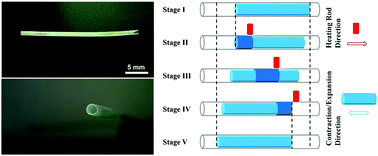Thermomechanical liquid crystalline elastomer capillaries with biomimetic peristaltic crawling function†
Abstract
It is highly desirable to fabricate liquid crystalline elastomer (LCE) devices with novel functions for applications in different areas. In this study, LCE capillaries with biomimetic peristaltic function are fabricated for the first time to mimic the peristaltic crawling locomotion of earthworms. A specifically designed LC cell was prepared for this purpose, which consisted of two coaxial glass capillaries coated with polyimide alignment layers on the inner cell surfaces. The side-on LCE capillaries were fabricated by photoinitiated polymerization/crosslinking of a monomer and a crosslinker in the LC cells. The results show that owing to the effect of the alignment layers on the LC cell walls, the mesogenic units in the network structures are predominantly oriented along the capillary axis. Reversible thermomechanical contraction and expansion are observed for the LCE capillaries, which show a relative contraction of 16% in the length and a relative expansion of 12% in the diameter upon the nematic to isotropic phase transition. When placed in a glass tube with an appropriate inner diameter, reversible peristaltic crawling locomotion of the LCE capillaries is realized by moving a heating source outside the tube along its axis. Under typical conditions, the peristaltic crawling motion shows a moving speed of 0.31 mm s−1. The mechanism of the peristaltic crawling of the LCE capillary is elucidated with the assistance of the finite elemental analysis (FEA) simulation. A five-stage motion model is established to rationalize these observations and correlate the observations with the crawling locomotion of earthworms. The LCE capillary with the peristaltic crawling locomotion function promises its potential applications in biomimetic miniature robots and actuators.


 Please wait while we load your content...
Please wait while we load your content...